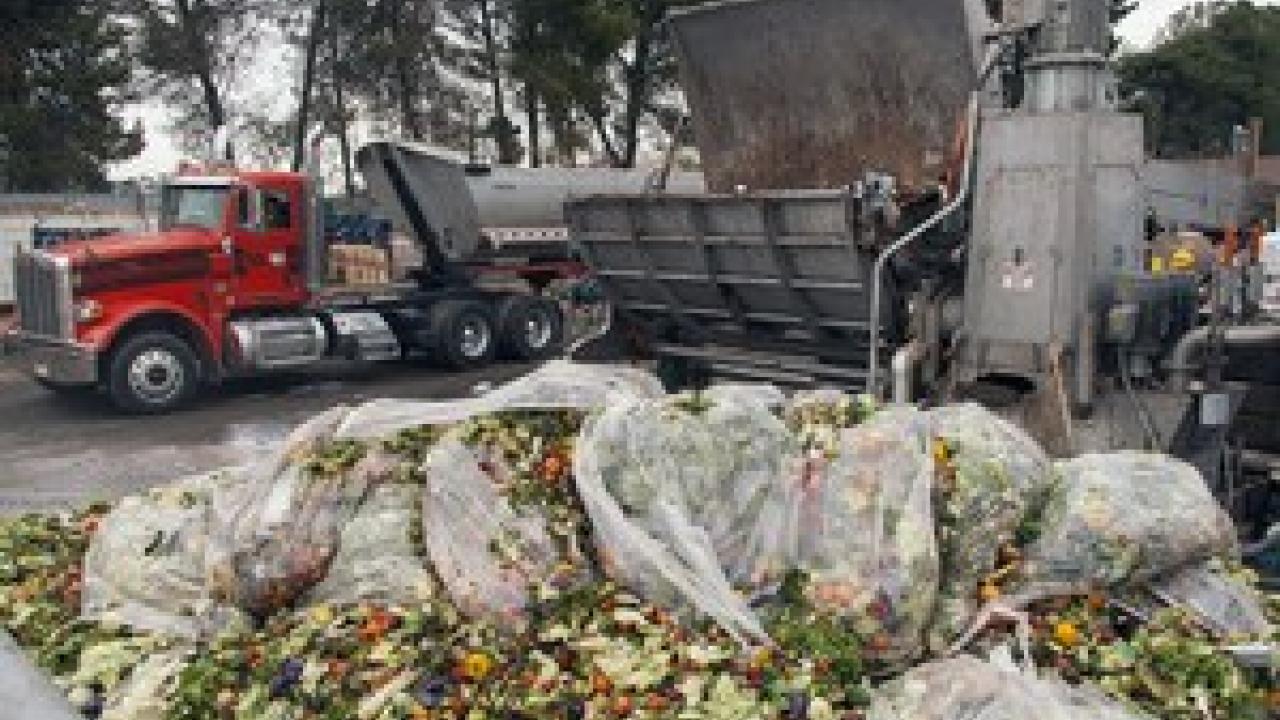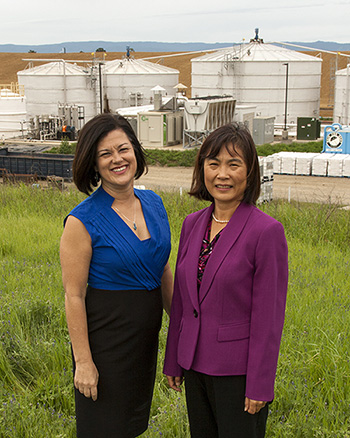
Waste Not, Want Not
UC Davis technology is helping transform organic waste into energy.
Technology developed at UC Davis by Professor Ruihong Zhang has turned a waste problem into an energy solution. Over the past decade, Zhang’s innovations in anaerobic digestion have carried the technology from lab to pilot plant to commercial enterprise.
Organic waste — it’s a problem. Food scraps, food processing discards, postharvest agricultural residue, paper, wood, and animal waste are all types of organic waste that clog landfills, emit greenhouse gases, and squander resources. According to the California Department of Resources Recycling and Recovery (CalRecycle), compostable organic waste makes up approximately one-third of the more than 30 million tons of waste that are dumped each year in California landfills.
Anaerobic digestion is one solution for transforming organic waste into a commodity, turning these materials into renewable energy and valuable fertilizer products.
“Anaerobic digestion is key in CalRecycle’s efforts to divert organic waste from California’s landfills,” said Caroll Mortensen, the director of the California Department of Resources Recycling and Recovery. “By converting this significant waste stream into low-carbon fuels and soil amendments, anaerobic digestion projects can help California reduce landfill use, cut greenhouse gases, and build healthy soils while creating the jobs of the future.”
Zhang, a CA&ES professor of biological and agricultural engineering, serves as chief technical adviser to CleanWorld, a private startup that has launched three commercial anaerobic digesters in the Sacramento area since 2012. “I call Ruihong the Steve Jobs of anaerobic digestion because her innovations in technology are based on an understanding of the user,” said Michele Wong, president of CleanWorld and a UC Davis alumna. “She solved the problems that the human race needed to solve with regards to organic waste. She understands who the customers really are, and she’s devised very practical, elegant, simple solutions.”
In anaerobic digestion, bacteria break down biodegradable material in the absence of oxygen. Food scraps and other forms of organic waste are dumped into large, sealed tanks that look like silos and serve as giant composters. Bacteria in the closed system convert the waste into methane and carbon dioxide, also known as biogas.
Biogas can be combusted to generate electricity and heat, or it can be processed into renewable natural gas and transportation fuels. Along with biogas, the digestion of organic waste produces a nutrient-rich effluent that can be used to make fertilizer and soil amendments.
“So it’s farm to fork to fuel, and back to the farm,” said Zhang. “We’ve closed the loop.”

Michele Wong (left), president and CEO of CleanWorld, and UC Davis professor Ruihong Zhang have worked as partners to commercialize anaerobic digester technology. (John Stumbos | UC Davis) - Michele Wong (left), president and CEO of CleanWorld, and UC Davis professor Ruihong Zhang have worked as partners to commercialize anaerobic digester technology. (John Stumbos | UC Davis)
Commercializing the technology
Knowledge of anaerobic digestion has been around for a long time, though CleanWorld president Wong noted that Zhang’s design innovations addressed the key obstacles to commercializing the process. “When Ruihong first began to imagine this technology a dozen years ago, she understood the challenges: we needed high gas-production efficiencies, the ability to process a wide variety of organic wastes, cost-effectiveness, speed, scalability, sustainability, and a small footprint,” said Wong.
The path to commercialization of Zhang’s technology began in 1995, when she first joined UC Davis and designed an anaerobic digestion process to biodegrade rice straw as an alternative to burning stubble left in the fields after harvest. With a patent in her pocket, Zhang attracted funding from the California Energy Commission, CalRecycle, and private companies to build a fully functioning pilot plant on the UC Davis campus.
Although the pilot plant required a significant expenditure of time and money, scaling up the technology captured the interest of investors who were reluctant to risk millions of dollars until they had seen an operational model. The pilot plant demonstrated that the technology could process tons of waste on site instead of grams of waste in the lab.
Zhang’s anaerobic digestion technology has attracted private partnerships. Raley’s, a privately held supermarket chain with headquarters in West Sacramento, became involved with Zhang and her project during the pilot phase by providing organic waste for testing in the biodigester. In 2015, Raley’s began shipping all produce discards from its 126 stores to commercial anaerobic biodigesters owned by CleanWorld. While the supermarket chain has long diverted its organic waste from the landfill, the corporation switched to anaerobic digestion disposal because it’s a win-win solution.
“If we can accomplish two goals with one action — save money by diverting organic waste from the landfill and also promote sustainability by helping create energy from waste — then we’ll go after that solution every time,” said Meg Burritt, director of wellness and sustainability for Raley’s.
Through public and private partnerships, Zhang has taken her anaerobic biodigestion research from innovation to commercialization. The next challenge is profitability, and the outlook is promising. “Our major focus right now is to improve the economics of biodigesters by developing products such as fertilizer and soil amendments from the digestate. We are researching the production of algae and other products from the digestate,” said Zhang. “We expect to earn substantial revenue from those in the future.”